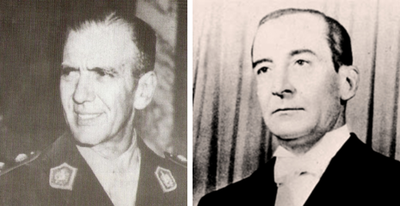Revolución Libertadora
This article has multiple issues. Please help improve it or discuss these issues on the talk page. (Learn how and when to remove these template messages)
|
| Revolución Libertadora | |||||||||
|---|---|---|---|---|---|---|---|---|---|
| Part of the Cold War | |||||||||
 Presidents Eduardo Lonardi and Pedro Aramburu, the first leaders of the post-Perón era in Argentina | |||||||||
| |||||||||
| Belligerents | |||||||||
|
| ||||||||
| Commanders and leaders | |||||||||
|
Héctor Cámpora |
| ||||||||
| Political support | |||||||||
|
|
| ||||||||
| Military support | |||||||||
|
Loyalists of the Argentine Armed Forces |
Dissidents of the Argentine Armed Forces | ||||||||
| History of Argentina |
|---|
 |
|
|
Revolución Libertadora (Spanish pronunciation: [reβoluˈsjon liβeɾtaˈðoɾa]; Liberating Revolution) was the coup d'état that ended the second presidential term of Juan Perón in Argentina, on 16 September 1955.
Background
This section needs expansion. You can help by adding to it. (April 2014) |
President Perón was first elected in 1946. In 1949,
However, economic problems, some of the government's policies, and Perón's own
By 1955, Perón had lost the support of a large part of the military, who conspired with other political actors (members of the
Military uprising
First coup attempt

On 16 June 1955, 30
In retaliation, extremist Peronist groups attacked and burned several churches that night, allegedly instigated by Vice-President Alberto Teisaire.
The only important political support for Perón came from the General Confederation of Labour (the main confederation of labor unions), which called the workers to defend the president. Perón addressed a workers' demonstration on 31 August.
September uprising
On 16 September, a new uprising, led by General
After realizing that the country was on the brink of a
On 23 September, Lonardi assumed the presidency and gave a conciliatory speech from the balcony of the Casa Rosada, saying that there would be "neither victors nor vanquished" (ni vencedores ni vencidos, replaying a phrase uttered by Urquiza when he was victorious over Rosas at the Battle of Caseros). General Lonardi promised that the interim administration would end as soon as the country was "reorganized". His conciliatory tone earned him the opposition of hard-liners, and in November an internal coup deposed Lonardi and placed General Aramburu in the presidency, giving rise to a wild "anti-Peronism".
Aftermath
This section needs expansion. You can help by adding to it. (April 2014) |
After the Revolución Libertadora, Perón and his followers were accused of treason, and Eva Perón's remains were moved secretly to Italy and buried in a graveyard at Milan under a fake identity. Public references to Perón or his late wife, including songs, writings and pictures, were forbidden. Even sportsmen like Delfo Cabrera, Mary Terán de Weiss, many of the major basketball players, as well as Olympic-level athlete, Osvaldo Suárez, were unfairly punished, by being accused of having gotten their sports success only because they were Perón followers.
The
References
- ^ Frezza, Juan (9 March 2019). "La Constitución maldita. Los peligros de la reforma de 1949". Revista Bordes (in Spanish). Retrieved 26 January 2020.
- ^ Firma, Va Con. "A 70 años de la Constitución de 1949, su plena vigencia conceptual | VA CON FIRMA, un plus sobre la información". vaconfirma.com.ar (in Spanish). Retrieved 26 January 2020.
Bibliography
This section is empty. You can help by adding to it. (April 2014) |
Online sources
- (in Spanish) Peronismo.
- (in Spanish) Historia Argentina: Los gobiernos de Perón.
- (in Spanish) Sucesos Históricos Argentinos.
- (in Spanish) Civiles y militares de 1955 a 1983.
- (in Spanish) La Revolución Libertadora en Internet
- (in Spanish) 16 de septiembre de 1955 – Golpe autodenominado “Revolución Libertadora”
Further reading
- Potash, Robert A. (1980) The Army and Politics in Argentina, 1945–1962: Peron to Frondizi Stanford, California: Stanford University Press, ISBN 978-0804710565


